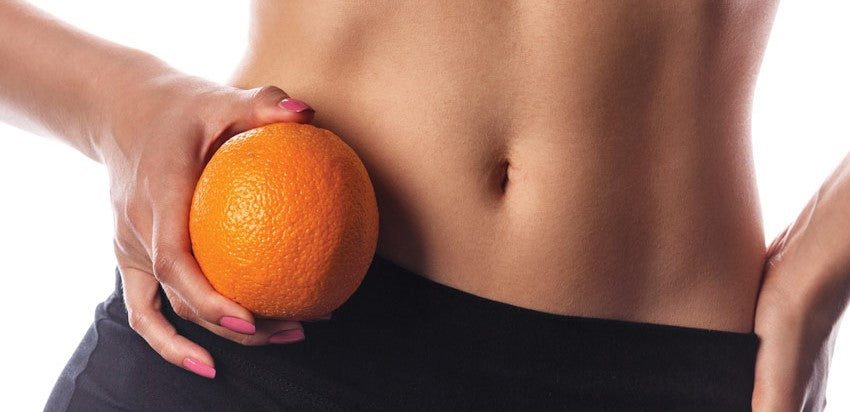Cellulite is a growing concern for most women in the United States, and it is unbiased to age or body type.1 In most cases, cellulite is inevitable and directly related to the many changes and other external factors the body goes through over time. Just as the process of aging is a natural progression, so is the development of cellulite. There are multiple stages or phases of cellulite with a range of causes and symptoms. Cellulite must be routinely treated and maintained to effectively manage and powerfully resist the rate of formation.
Cellulite is an easily identifiable, fat tissue-related disorder accompanied by visible characteristics. It is identifiable by its dimply texture, comparable to an orange peel or cottage cheese. Cellulite areas can be cooler to the touch than other surface areas of the body. Understanding what cellulite is, how it engenders and the dominant causes are essential for professionals to be able to effectively treat and resolve the problem areas and make a difference for every client.
“The key to treating cellulite is to boost blood circulation and fat metabolism.”
What is Cellulite?
Cellulite is localized lipodystrophy, or a degenerative condition of the body’s adipose tissue. Damaged fat tissue occurs in specific areas of the body, typically in the hips, thighs and buttocks. Impaired adipose fat tissue is ultimately non-responsive, causing an interruption in the circulation and flow of the lymph, fat and fibers that exist in the tissue. The subcutaneous layer of the skin is where the fat tissue is located. The most significant culprit to cellulite genesis is estrogen levels, so most women develop cellulite due to high estrogen levels, while men do not. Furthermore, the connective fat-tissue for men is much thicker than for women, so it does not allow the fat pockets to form and result in hollowed dimpling.2 The softer connective fat-tissue in women is susceptible to the dimpling because the fibers and protein in the adipose layer accumulate and become stagnant in a matrix-like pattern, and the soft tissue collapses on a micro level through these pockets that form. The key to treating cellulite is to stimulate and trigger a physical response from the areas by boosting blood circulation and fat metabolism.
Fat Receptors
Throughout the body, there are fat storing and fat releasing receptors; they determine where cellulite is predisposed. As mentioned earlier, cellulite areas tend to be cooler to the touch because those areas are afflicted. The main cellulite areas for women are just below the waist, hips, thighs and buttocks. For women, these areas have six times more fat-storing than fat-releasing receptors than anywhere else in the body. By comparison, men have six times more fat-storing receptors around the abdomen area. This is a contributing reason why men are not likely to suffer from cellulite, but the balance of the fat receptor allocation in the body is a greater health risk for men.
Cellulite is not exactly esthetically pleasing, but in most cases, it is more of an appearance issue for women than a deep-rooted health problem. The allocation of the fat-storing receptors actually puts men in jeopardy of serious health conditions especially if they are overweight. In men, the fat located in the abdomen wraps itself around the organs. In women, the fat-storing receptors are away from the organs. Cellulite is a symptom that stems from a variety of factors, which can actually be indicators of other health related concerns, such as circulation, hormonal balance and other reasons we will further examine. Ultimately, cellulite itself does not pose a health threat to women. The presence of cellulite is normal. In the words of Dr. Nürnberger and Dr. Müller, cellulite is, “an invented disease.” In 1978, they established a grading system to assess and determine the severity of the cellulite.3
Grades of Cellulite
The original cellulite scale ranged from zero to three, according to Nürnberger and Müller, but it is commonly categorized as one to four today. Examining cellulite in accordance with the modern scale can be done with the guidelines below.
Grade 1. The mildest or practically non-existent type of cellulite is identified as Grade 1. This grade does not exhibit any signs of dimpling, even when the surface is pinched.
Grade 2. This grade of cellulite most often does not raise much concern for women. Dimpling is noticeable only if the area is pinched or compressed; when standing, the surface appears smooth and even.
 Grade 3. An overwhelming amount of women who have Grade 3 or higher are emotionally and psychologically impacted by the esthetically undesirable condition. They are self-conscience about their physical appearance, uncomfortable in social settings and may even have a lower self-esteem. Grade 3 cellulite has prominent dimpling but only when standing up.
Grade 3. An overwhelming amount of women who have Grade 3 or higher are emotionally and psychologically impacted by the esthetically undesirable condition. They are self-conscience about their physical appearance, uncomfortable in social settings and may even have a lower self-esteem. Grade 3 cellulite has prominent dimpling but only when standing up.
Grade 4. This grade of cellulite is indefinitely visible. It is noticeable when standing, sitting and especially when the area is squeezed.
Soft vs. Hard Cellulite
Cellulite may be soft or hard, but it depends on the kind of cellulite.
Soft cellulite. Soft cellulite is close to the surface and is easier to treat than hard cellulite, which is deeper in the subcutaneous tissue. Soft cellulite is the most common and responds relatively quickly to appropriate cellulite therapy. The dimples may appear to be comparable to cottage cheese, a soft sinking-in-like texture. Edematous cellulite, a type of soft cellulite, is a result of fluid retention. It can be related to diet or an individual’s level of daily activity. The fluid retention and poor circulation causes swelling that can spread to the lower extremities of the body. Nodules may be felt in the fat tissue as well, and it may be bothersome. Consistent treatment and some lifestyle changes prove to be successful in rectifying the problem.
Hard cellulite. Hard cellulite is deeper; it sits close to the muscle or may be attached to the muscle. It requires much more intense, deeper and aggressive stimulation and manipulation of the area to initiate movement and flow of the stagnant fat. Boosting lymphatic and fat drainage is vital to promote healthy adipose tissue.
Hard cellulite, also known as fibrotic cellulite, is the most severe. It is common among athletic body types. In some cases, it may appear to look mild, but actually, the cellulite is just hidden. It is more difficult to treat because the tissue fibers combined with the fat are denser. Hard cellulite can be stubborn and resistant to treatment initially. Women suffering from hard cellulite can experience pain and sensitivity because the circulation is compromised in the cellulite areas. In such cases, the cellulite stricken areas tend to be a cooler temperature to the rest of the body.
Primary Causes
Many women experience the frustrations of doing everything right when it comes to taking care of their bodies, yet they still are faced with feeling powerless in getting rid of cellulite. For a healthy individual that works out regularly, the cellulite may become worse because it hardens and compresses closer to the muscle. In other cases, weight-loss may exacerbate soft cellulite. Cellulite is damaged tissue, which is non-responsive or slow to respond. The catalysts of cellulite include, but are not limited to, a person’s diet, hydration, stress levels, environmental exposure, daily physical activity, genetics and hormonal fluctuations.
Eating a balanced, healthy diet high in nutrients and low in sodium supports adipose tissue health, while drinking lots of water throughout the day helps facilitate the flow of fat and lymph throughout the body. Exercising promotes overall wellness and also activates the production of endorphins, which ultimately help counter the effects of stress. These are just some basic tips to proactively resist cellulite.
Pregnancy, post pregnancy, menopause and the use of hormonal medications are all hormone-related reasons cellulite may develop or become worse. Since women’s hormonal equilibrium is estrogenically dominant, the endocrine hormone producing glands in women attribute to all layers of skin being thinner than that of men. This means that the connective fat tissue is also thinner. As a result, fat cells are predisposed to collapsing through small compartments that develop throughout the adipose tissue between the fibers, leading to cellulite formation.
Boosting Circulation is Fundamental
Poor circulation is both a cause and effect of cellulite. A simple way to boost the circulatory system is through contrast showering, or switching the water from hot to cold. In general, treatments that enhance circulation in cellulite problem areas may cause redness and sensitivity but with purpose. The increased flow of lymph and fat will break down the accumulated stagnant fibers and proteins in the fat tissue that are responsible for the uneven texture. By jump-starting the internal fat drainage cycle, it will facilitate the breakdown of cellulite, and work to smooth, tone and contour the targeted areas.
Anti-cellulite Ingredients

There are a variety of recommended ingredients that effectively work to battle with cellulite. Capsaicin derived from cayenne peppers, caffeine, theophylline, rhodysterol from red algae and mustard seed powder are among some of the more potent cellulite fighting ingredients. Antioxidant rich ingredients including aminophylline, aloe and sea buckthorn are critical in neutralizing free radicals, which are destructive to healthy tissue. Overall, the potency of cellulite-targeting ingredients work to break down fat deposits that accumulate under the skin and accelerate the process of tissue regeneration.
Cellulite Is Normal
Cellulite is mostly an esthetic condition. Although cellulite can be frustrating for women, it is normal for most women to have it. Just like the on-going journey to keep the skin on the face looking youthful and free of wrinkles, there is a desire to keep the skin on the body looking smooth and free of cellulite. Untreated cellulite accumulates just as chronological aging never stops. Ultimately, most types of cellulite can be remedied with appropriate spa treatments and home product use, but consistency and patience are required.
References
- S Luebberding, N Krueger and NS Sadick, Cellulite: An Evidence Based Review, American Journal of Clinical Dermatology 16(4): 243-256 (2015)
- F Angehrn, C Kuhn and A Voss, Can Cellulite be Treated with Low-Energy Extracorporeal Shock Wave Therapy? Clinical Interventions in Aging 2(4) 623-630 (2007)
- F Nürnberger and G Müller, So-Called Cellulite: An Invented Disease, The Journal of Dermatological Surgery and Oncology 4(3): 221-9 (1978)


Muchas gracias. ?Como puedo iniciar sesion?